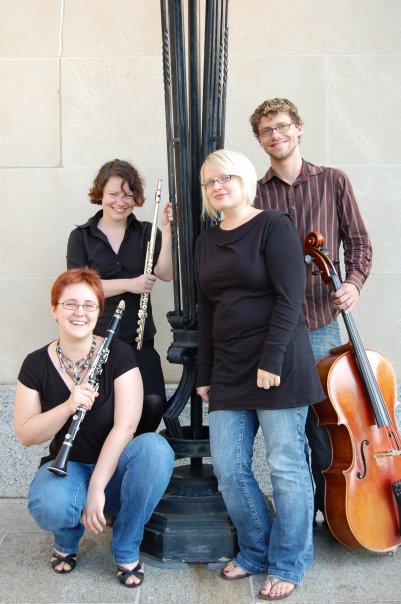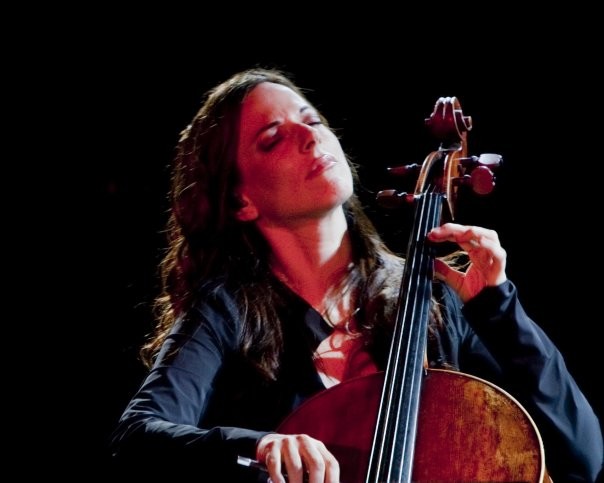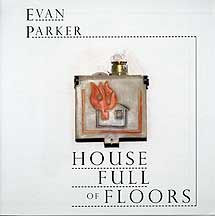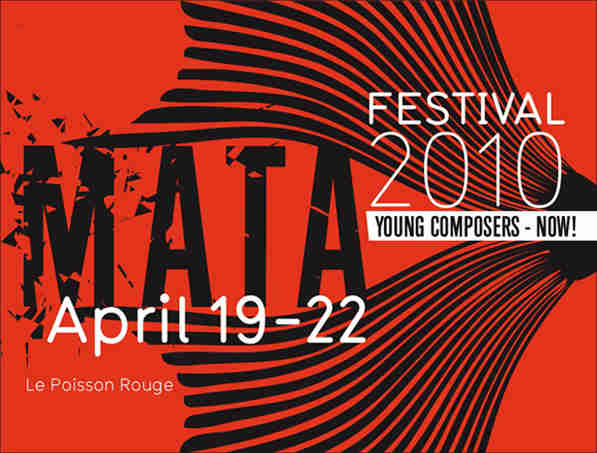
A [filmic] image combined with a sound placed in a context--none of which matches expectations--creates a metaphor and invites an individual search for meaning at a physical, emotional and psychological level (in that order).”
— Paul Rudy, UMKC Conservatory.
T he performance last night at Unity Temple by the electroacoustic quartet
Quadrivium Novum was the final event of the 2009-2010 season for the Kansas City Electronic Music & Arts Alliance,
KCEMA.
Q uadrivium is comprised of Rebecca Ashe (flute), Kari Johnson (piano), Cheryl Melfi (clarinet), and Mark Stauffer (cello). [‘Quadrivium’ may not only allude to their quartetness but also to each member’s equal, autonomous role in bringing new, disruptive repertoire and techniques to the ensemble’s collaborations—much as though each member were a canonical
‘subject’ to be studied, learned, mastered?] Each of Quadrivium’s members is associated with the UMKC Conservatory’s
Community Music & Dance Academy.
- Daniel Eichenbaum: Orbit (flute, clarinet, live electronics; 20 min)
- Jason Bolte: Scrap Metal (prepared piano solo, fixed media; 10 min)
- Mara Gibson: E:Vespers (flute, clarinet, piano, digital audio; 8 min)
- Andrew Seager Cole: A Slow Unraveling (flute, clarinet, cello, piano, electronics, video; 8 min)
- William Lackey: The World Falls Asleep (cello, digital recording of cello; 10 min)
- Christopher Biggs: Bioluminescence (flute, clarinet, piano, digital audio, video; 12 min)
E ach of the works was rewarding, and I should apologize for not commenting here on each of them. Let me at least offer a few impressions of the three pieces that were world premieres: ‘E:Vespers’, ‘Orbit’, and ‘A Slow Unraveling’.
M ara Gibson’s ‘E:Vespers’, a ‘fantasie’ or tone-poem composed on the occasion of observing an eclipse, was remarkable for the organic, natural way in which the digital audio functions as an equal to the three live performers. The partitioning of human assistants and digital tracks programs all the tasks into one application, run by a single assistant at the console workstation in the center of the performance space. This approach does not ‘reduce’ the interpretation to ‘assistant vs. trio’ duality, nor does it risk dichotomizing the technology and the performers at the front of the performance space. Rather, with the house lights dimmed, the effect is one of a thoroughly integrated ‘whole’ in which the individual parts reveal their character and ideas—beginning with the tolling of delicate, repeated notes by the piano.
T he technology actually helps to maintain the textural and timbral cohesion of the other parts (clarinet, flute, piano), whose acoustic spectra are otherwise diverse. Unlike some electroacoustic works in which the technology is intrusive or merely ornamental; unlike works where the digital tracks, having been laid down and sequenced in advance, are inflexible and impose too much determinism on the live executants. In the case of Gibson’s ‘E:Vespers’, the composer is still the creator, and the 3 performers and 1 assistant are the directors in charge of interpreting the musical elements of the work, whether they are for an acoustic instrument or combined with a computer sequencer. The performers are responsible to recreate the world the composer has envisioned: here, a contemplative, reverent, panoramic one—punctuated with worries but ultimately beneficent—captured in the twilight of the eclipse and return of the sun after 'totality'.
W e orbit and float in our space gondola and watch the oceans and islands and green hills of the continent pass by at five miles per second. We move silently and effortlessly past the ground. I want to say ‘over the ground’ as I write this, but remember: in space, your sense of up or down is completely gone and my description must reflect this fact. In addition, the breathtaking speed of the ship is an odd and confusing contrast to the feel of perpetually floating within the spaceship. You do not sit before the window to view the passing scene, certainly not down upon it. Are you speeding past oceans and continents, or are you just hovering and watching them move beside you?”
— Joseph Allen, U.S. astronaut.
D aniel Eichembaum’s ‘Orbit’ is an antiphonal piece for flute, clarinet, and electronics. Rebecca Ashe and Cheryl Melfi are dressed in black, in near-total darkness, barefoot. They perform Orbit’s several movements as a duo, gliding anticlockwise between the four ‘stations’ that are set up on-stage. The stations are separated around the perimeter of a 10-meter circle whose perigee is closest to the audience and apogee farthest away.
T he ephemeral, ambient quality of electroacoustic elements is abundant, at times dominant. But it is important to note that the digital tracks are derived entirely from recordings of Rebecca’s and Cheryl’s own playing, breathing, moving—not from Eichenbaum’s digital waveform library or independent geek artistry in a vacuum. Extensive digital signal-processing (DSP) and editing have been done to produce what are now rendered by the sequencer in performance as, say, massive, rocket-like, spine-shaking ‘rumbles’ [from the multiple studio monitor speakers that are arrayed around the performance space, controlled from the assistant’s digital audio workstation console] or celestial chirps or high-energy quantum particle ‘tweets’. We had no idea of this in advance. But when Rebecca and Cheryl remarked after the performance that all of the electroacoustic effects we had just heard during this piece had begun from sounds that they themselves had made, and that Eichenbaum had recorded and processed and sequenced them as the three of them sat together at the DAW console in the studio, it was heartwarming evidence of a deeper sort of collaboration between performers and composer. Composer/DAW-artist/engineer as performer; performers as engineers/editors/co-composers. There is something profoundly ‘right’ about this.
W hat I mean is, composers, performers, computer musicians/DAW-artists have accepted, for the most part, the progressive abstractions from older analog and now-obsolete digital hardware into software modules and sequencer patches... not just ‘miniaturization’ per se but now total automation and virtuality, including software to manage the multiple applications and equipments and software to insert random aleatorics and emulate human-like variability effects. These abstractions are motivated by reliability, by productivity for the composer, by aesthetic considerations—all valid and admirable. But the abstractions have incrementally impoverished the electroacoustic performance experience, I think—compared to, say, my first experience of a
Moog Synthesizer as a child of 10 at the Minneapolis Symphony (now Minnesota Orchestra) in 1963, teeming with patch-cables and wires and mad-scientist musician (I regret I cannot remember who, or which composers’ works were performed) at the keyboard, clearly *not* in complete control.
 B
B ut in Eichenbaum’s ‘Orbit’ we have a focused assimilation of the digital and acoustic environments, in which the digital realization is a cohesive part--‘gluey’ elements that hold the entire composition together. The live performers are not ‘bystanders’. They are confronted, yes, by their own DSP-processed previously-recorded sounds. They are reacting to the aleatoric expressions of the DAW assistant who is reincarnating the sequences at one remove, so to say. And they know this, even though we in the audience did not, until the remarks following the performance.
H aving heard Rebecca’s and Cheryl’s post-performance commentary on ‘Orbit’, though, we now comprehend aspects of the performer-electronics interactions that we hadn’t grasped at first hearing: the intimacy of the part that you are now playing, live; the musical subtleties of rediscovering the state-of-mind you were in when you made the sounds that you are now hearing emanate from these electronics; the expressive stimulation of being re-reminded now, of how that sequencer patch was co-edited by you and Daniel not so long ago. This can be a truly productive process—and a provocative montage of active, creative roles and meta-roles for performers in their interpretations of electroacoustic music, as it was with the Quadrivium performance last night!
W hat else? The noise gradations range from total silence (a bus is heard faintly, passing by outside Unity Temple on 47th Street) to 100 dB butt-shaking. ‘Really Noisy’ (what Stockhausen would call ‘sehr geräuschaft’)–filtered ‘pink’ noise and rumbling ‘red’ noise, convolved with other signals on the track to the point where it pervades the space and progressively washes out and obscures Rebecca’s flute and Cheryl’s clarinet. ‘Sort of Noisy’ (‘etwas geräuschaft’) – square and sawtooth waves convolved with the rest, but with enough high-frequency spectral content to meld with and preserve the listener’s attentiveness to upper-register activity in the flute and clarinet parts... A dense polyphony, reminiscent of György Ligeti’s writing for the score of the film ‘2001: A Space Odyssey’: a choir of myriad voices; the mixing and intermingling and asynchronous entries and departures of thousands of voices; microtonal voices, sounding notes a quarter-tone higher or lower than their neighbors; cosmic cacophony tending toward pantheism.
A ndrew Seager Cole’s ‘A Slow Unraveling’ applies combinatoric permutations to tiny musical elements to generate large [fractal?] structures. The fast-tempo elements that begin the piece devolve into slower ‘child’ elements that enclose and subsume the ‘parents’ until the music completely unravels, finally coming to a rest. The music was genuinely interesting and admirably executed, regardless of its formal compositional methods and inspiration. Kari Johnson’s piano and Mark Stauffer’s cello were especially compelling, as regards imbuing the piece with vivid kinesthetic impressions of velocity and depth/space. The piece has narrative; a story unfolding among the performers. It is intimate ‘chamber music’, yes. But it is the paradoxical ‘intimacy’ of space itself, on an astronomical scale.
B ravo!























